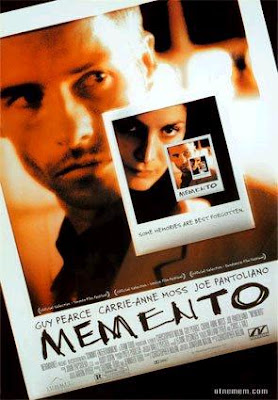
Are you watching closely?
Christopherl nolan's mind-boggling methods of storytelling
(read: art) become apparent when he applies the central
theme of the story to the style in which it is told. The
only two nolan films that i have seen (memento and the
prestige) have experimented in directorial styles that
trancend conventional movie making methods, and add to the
story in ingenious ways.
The prestige, presents a story that is simply about two
magicians and the rivalry between them, but is told non-
linearly, and in the format of a three part magic trick.
The entire movie is presented as a magic trick is.. a lot
of showmanship, a lot of distraction...and then the ending
leaves you stunned, and wondering how exactly the trick
was done. The movie left me feeling cheated, and the
ending was something that didn't make sense, and i felt like
there was something i was missing, cuz what was shown was
surely one big trick, and the way the entire thing was
done had to be simple, logical and possible. Thats when it
hit me... Nolan was making the audience feel like they had
witnessed a really good magic trick, where you dont really
accept it because you know there is no such thing as
magic, and yet you dont have a logical explanation for
what you've just witnessed. Really good magicians awe
audiences when they witnesses something they believe to be
impossible... Exactly what the film did for me. The movies
punchline "are you watching closely?" really hints at a
much deeper layer as is the case with all of nolan's
films. Any film that leaves me thinking for days after i'd
seen it and makes me think about the various possible
solutions to the ending i've witnessed, each one as
incredible as the next has to be classified as a brilliant
movie.
The fact that both these films (memento and the prestige)
have so much beyond the obvious ensures that a second
viewing puts an entirely different perspective on the
entire film. This is one that might leave you a bit
Christopherl nolan's mind-boggling methods of storytelling
(read: art) become apparent when he applies the central
theme of the story to the style in which it is told. The
only two nolan films that i have seen (memento and the
prestige) have experimented in directorial styles that
trancend conventional movie making methods, and add to the
story in ingenious ways.
The prestige, presents a story that is simply about two
magicians and the rivalry between them, but is told non-
linearly, and in the format of a three part magic trick.
The entire movie is presented as a magic trick is.. a lot
of showmanship, a lot of distraction...and then the ending
leaves you stunned, and wondering how exactly the trick
was done. The movie left me feeling cheated, and the
ending was something that didn't make sense, and i felt like
there was something i was missing, cuz what was shown was
surely one big trick, and the way the entire thing was
done had to be simple, logical and possible. Thats when it
hit me... Nolan was making the audience feel like they had
witnessed a really good magic trick, where you dont really
accept it because you know there is no such thing as
magic, and yet you dont have a logical explanation for
what you've just witnessed. Really good magicians awe
audiences when they witnesses something they believe to be
impossible... Exactly what the film did for me. The movies
punchline "are you watching closely?" really hints at a
much deeper layer as is the case with all of nolan's
films. Any film that leaves me thinking for days after i'd
seen it and makes me think about the various possible
solutions to the ending i've witnessed, each one as
incredible as the next has to be classified as a brilliant
movie.
The fact that both these films (memento and the prestige)
have so much beyond the obvious ensures that a second
viewing puts an entirely different perspective on the
entire film. This is one that might leave you a bit
dissapointed at first, but then again, you can't always believe
what you see

